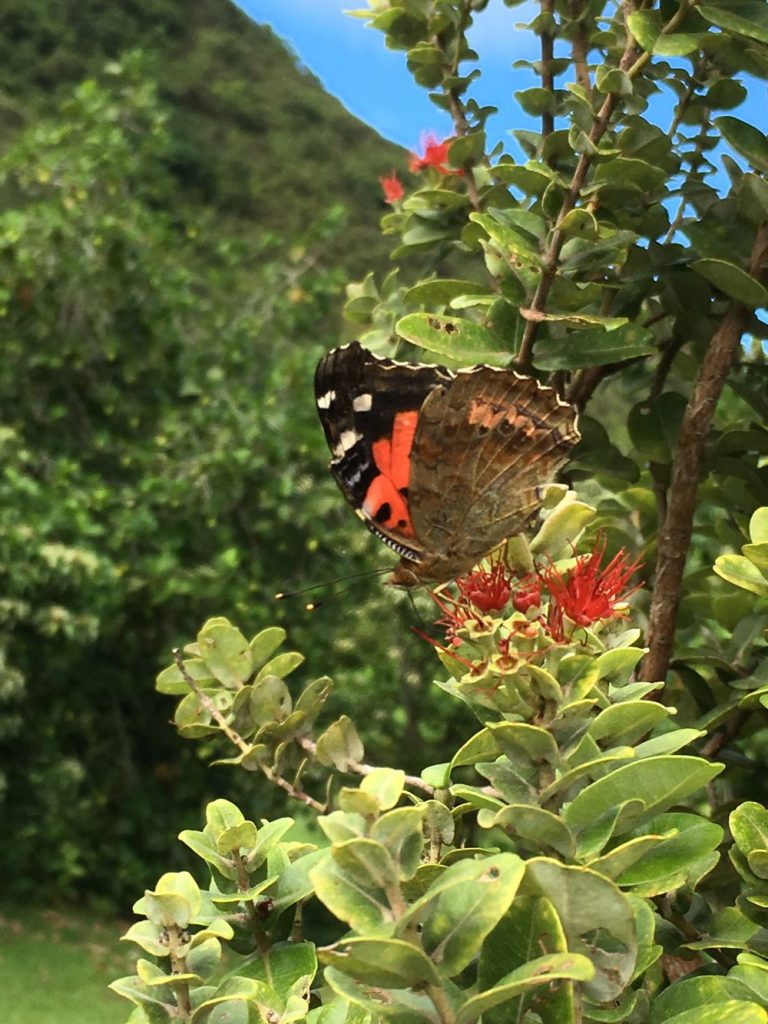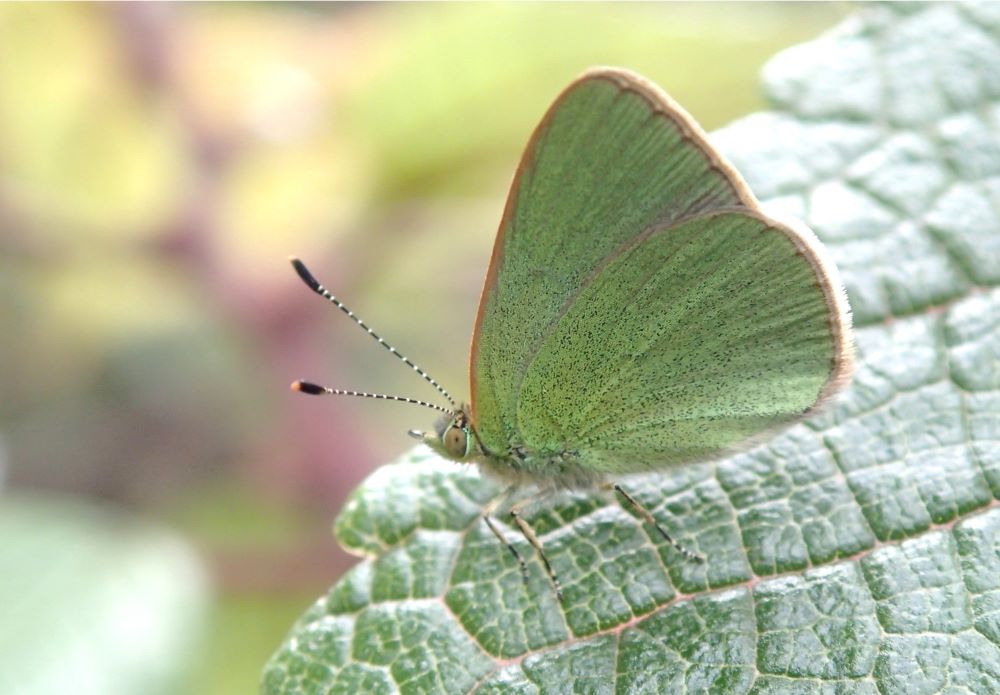Hawai‘i’s 2 Endemic Butterfly Species, Including Iconic Kamehameha, on Decline
By all accounts, the monarch butterfly is doing well throughout the Hawaiian Islands. But that doesn’t mean all butterfly species that call the state home, including the Big Island and Kaua‘i, are flourishing.
There are two endemic butterflies, including an iconic species designated as the state insect, that could use some help, even if it’s simply people being more aware of them.
“Considering the abundance of monarchs across Hawaiʻi, it would be better if people planted Native Hawaiian plants to help our two native butterflies, the Hawaiian blue and the Kamehameha butterfly,” Daniel Rubinoff, a professor of entomology at the University of Hawai‘i-Mānoa who works on insect conservation, evolution and invasive species, told Big Island Now.
The Kamehameha butterfly, the Hawai‘i state insect, and Hawaiian blue butterfly are the only butterfly species that are native to the islands, according to William Haines, a research entomologist with the state Department of Land and Natural Resources Division of Forestry and wildlife.
“We have over 5,000 species of endemic insects or arthropods,” said Haines, who manages a captive rearing facility focused on raising rare and endangered insects in an attempt to establish new populations. “We have a ton of native insects, but only two of those are butterflies.”
That might seem a little unusual, but the circumstances behind how butterflies get to the islands and then stay provide an explanation.
“The thought of why we have so few native butterflies that established here was because butterflies tend to be very host specific, so their caterpillars can usually only eat on one or a few different kinds of plants,” Haines said. “So not only did they have to make this incredible journey over the Pacific Ocean and somehow find the Hawaiian Islands, but their host plant also had to already be here for them to establish.”
Host plants play a huge role in how well the populations of the two butterflies fare. So when those plants are threatened by predators and pests, especially those that are invasive, so, too, are the caterpillars that eventually become butterflies. While adult butterflies can feed on the nectar of flowers and tree sap, their caterpillars need specific host plants to survive.
That’s exactly what is happening to the Kamehameha and Hawaiian blue butterflies.
Both butterflies can be found on Hawai‘i Island, Maui, Moloka‘i, Lana‘i, O‘ahu and Kaua‘i. The Hawaiian blue butterfly also can be found on Kaho‘olawe, but the island’s dry conditions are not suitable for the Kamehameha butterfly’s host plants and therefore it is not found there.
“Historically, both butterfly species occurred at low and high elevations, but nowadays, they tend to be more abundant in upland areas, since lowland areas not only have more invasive plants but also are infested with invasive predators such as ants,” Haines said, adding that ants are not native to Hawai‘i and the islands now have more than 60 established species of nonnative ants.
Yellowjacket wasps are another invasive species that can be devastating to caterpillars.
The Kamehameha butterfly, Vanessa tameamea, has several host plants, all native plants in the nettle family. The most common is mamaki. Most of these grow in wet areas such as gulches and forest understories.
The Hawaiian blue, Udara blackburni, is a little more flexible, according to Haines; however, the insect is still only able to use a few host plants, chiefly koa and a shrub called ‘a‘ali‘i. It’s also possible caterpillars can use nonnative acacia trees to some degree. ‘A‘ali‘i and koa occur in a wide range of habitats, from dry to wet, meaning the Hawaiian blue is somewhat more widespread than the Kamehameha butterfly.
While human development and agriculture destroyed a lot of native forests throughout the islands, and thus host plants for the two butterfly species, the threats to the food supply for their caterpillars now are primarily invasive plants.
“They are encroaching on native forest and very difficult to control,” Haines said.
There also is the constant threat of introduced diseases and pathogens.
“Just like rapid ‘ohi‘a death is caused by an introduced pathogen, fungi have been accidentally introduced that affect mamaki and other butterfly host plants,” Haines said. “With importation of plants, produce, soil, etc., there is always the threat of importing something new that could devastate one of our native plants.”
Host plants also determine the range of each of the butterfly species.
Because insect populations can fluctuate wildly during a matter of months, often having “boom and bust” dynamics because of their short lifespans and high reproductive rates, Haines said rather than population sizes, scientists generally look at the distribution of the species and whether its overall range is shrinking or remaining stable.
The Hawaiian blue and Kamehameha butterflies are both being pushed to higher elevations because of invasive species. And while both species are declining because of the reasons already mentioned, for the state insect, which isn’t as widespread as the Hawaiian blue, the situation seems to be more dire.
“For the Kamehameha butterfly, although it is not endangered, its range is definitely declining,” he said. “Although it can still be reliably found in some parts of its range, it has disappeared from many. Generally speaking, its range has been pushed up to higher elevations and into the backs of valleys.”
But even in those areas where the butterfly still occurs, Haines said residents say the butterfly has become rarer through the years.
“At lower elevations, there’s just not as much habitat, not as much viable habitat,” Haines said. “Even if you were to plant the host plants at low elevation, there would be the predator issue.”
There are ways residents can help.
“Depending on where people live, planting mamaki may help expand habitat for the Kamehameha butterfly, particularly at high elevation areas near the current range of the butterfly,” Haines said, adding on the Big Island that would be in areas such as Volcano, Mountain View, Kaloko Mauka and even upper Hilo.
But to make the mamaki a more viable habitat for the insect, the caterpillars need to be protected from ants.
“This can be done either by applying ant bait in the area or applying non-toxic, sticky barriers to the trunk of the tree to prevent ants from climbing it,” Haines said.
When it comes to the Hawaiian blue butterfly, anyone in Hawai’i can provide potential habitat by planting ‘a‘li‘i in their yard, he said, since the insect is more widespread and seems to be more likely to colonize in residential areas.
The key, according to Haines, however, might be something as simple as knowing the butterflies are here.
“I think people are generally aware that the Kamehameha butterfly is out there, and people know it is special and unique to Hawai’i, but I think a big reason why it isn’t on the forefront of people’s minds is that most people do not encounter the butterfly or have an opportunity to get into the areas where it still occurs,” he said. “The Hawaiian blue is small, less conspicuous and fast-flying, and there are several nonnative species that look similar, so even though it is more common than the Kamehameha butterfly, it is more easily overlooked.”
More outreach and education about the butterflies also can help.
Haines initiated a “citizen science” project during his previous work at the University of Hawai’i where people could submit observations of the Kamehameha butterfly to a website. That project, the Pulelehua Project, is no longer actively funded, but it was moved onto iNaturalist, a global database where people can submit photo observations via an app and then a community of naturalists help identify what they saw. Those who use the app also can see what other participants sighted in their neighborhoods.
“This is a great way for people to learn not only about butterflies, but all the plants and animals in their environment,” Haines said.
You can find the Pulelehua Project in the iNaturalist database by clicking here.
“Any kind of environmental education efforts should involve more native insects, in general,” Haines said. “People are actually a lot more aware of Kamehameha butterflies than they are, virtually, any other of our 5,000 native insects.”
He added that butterflies are generally popular.
“I think that’s why the citizen science effort actually did take hold and did drum up a lot of interest because people are predisposed to sort of like butterflies,” Haines said. “We were able to kind of tap into that interest.”
More projects like the citizen science project and additional funding for these types of programs and environmental education would help raise awareness. It’s also just a matter of people opening their eyes and looking at what’s around them.
“Apps like iNaturalist are great for that because it’s almost like Pokémon,” Haines said. “They start collecting these observations around them and then put them online and people ID them, and they say, ‘Oh, I’ve never seen that before. That’s really cool that you found it in Hilo.’ It opens up a whole other world for people.”



















